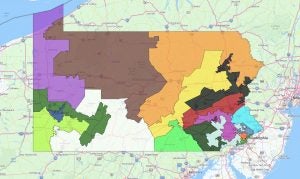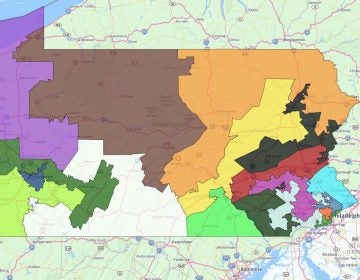Wolf administration rejects GOP congressional map proposal [updated]
Listen 1:18The interactive map above shows the boundaries of Pennsylvania’s 18 congressional districts as proposed by top Republicans. Gov. Tom Wolf does not believe the map is fair.
Gov. Tom Wolf has rejected a Republican-drawn congressional map designed to replace one the Pennsylvania Supreme Court declared unconstitutionally gerrymandered late last month.
Wolf said the new map proposal still favors Republicans too heavily — though House and Senate Republican leaders maintain it follows the court’s order exactly.
The rejection comes just two days before Wolf’s deadline to submit a map to the court, after which justices say they will choose one — either by picking a version they deem fair or drawing their own.
Wolf hired Tufts University professor Moon Duchin to analyze the GOP map.
In a statement, she said her statistical and mathematical analysis showed the proposal is “an extreme outlier,” when compared with other plans within the court’s constraints, “exhibiting a decidedly partisan skew that cannot be explained by Pennsylvania’s political geography or the application of traditional districting principles.”
That partisan tilt in favor of Republicans, she said, has only a 0.1 percent chance of coming about by chance.
Wolf spokesman JJ Abbott said that is grounds for throwing the map out.
“The opinion makes clear that the standard by which [the current map] was deemed unconstitutional was that it gave distinct advantages for a particular political party,” he said. “We believe the map that was submitted to the governor contains similar, if not the same advantages in a partisan direction, and using the same tactics as the current map.”
But Republicans said they interpreted the court’s decision very differently.
GOP weighs in
Senate Majority Leader Jake Corman said Wolf’s argument the GOP has a partisan advantage isn’t relevant — just a side effect of Democrats largely being confined to cities.
“There’s not any standard in what the Pennsylvania Supreme Court said or anywhere in the federal government or any court ever that says competitiveness is a standard,” he said.
Republicans have won 13 of Pennsylvania’s 18 congressional seats in the three elections since the maps were redrawn, although Democrats have more registered voters statewide.
When they first proposed the map to Wolf, Republican authors were adamant they hadn’t even taken partisanship into consideration.
“If you ask me the R and D split of that map, I have no idea what it was,” top Senate Republican lawyer Drew Crompton said at the time.
That map was submitted without a vote from the Legislature — a cut corner leaders said was necessitated because the Supreme Court issued its full ruling just three days before the map was due to the governor.
They insist they met all the court’s specifications — namely, that the congressional districts be “composed of compact and contiguous territory; as nearly equal in population as practicable; and which do not divide any county, city, incorporated town, borough, township, or ward, except where necessary to ensure equality of population.”
In a letter to House and Senate Republican leaders, Wolf laid out several of the specific concerns he had with the map. Besides the fact that the full Legislature didn’t vote on it, he said the map employs “packing,” “cracking,” and “splitting.” Respectively, those mapping methods involve squeezing densely populated areas into small districts, connecting cities to rural areas — here, Wolf cited Republican treatment of Reading and Erie — and dividing “key areas” such as cities and counties.
‘Quit being coy’
Republicans largely scoffed at those suggestions; Corman called for Wolf to offer his own map instead of making critiques — and he accused the governor of shutting the General Assembly out of the process so the Democratic-majority Supreme Court can draw the maps.
“He just laid out sort of these ridiculous reasons that it’s not meeting his standards,” Corman said. “To me, the only standard I can see is it’s not electing enough Democrats. Which, I can’t really help.”
Corman said the Republicans are currently looking at their options.
Ideally, he said, they would like more time to go through a legitimate legislative process with hearings and votes, though there’s currently no plan to appeal to the court for an extension.
House Speaker Mike Turzai and Senate President Pro Tempore Joe Scarnati took a similar tone in a joint letter to Wolf, which called his rejection of their map “nonsensical” and told him to “quit being coy” and release his own map.
“We look forward to reviewing your ‘fair’ map and are ready and willing to meet at your earliest convenience to see if, together, we can reach consensus on a ‘fair’ map that can garner majorities in the House and Senate and that you will sign,” they said.
However, Abbott indicated the ball is still in the legislature’s court, which could mean a standoff.
“I mean we gave them specific feedback as to our concerns related to their map … they are constructive,” he said. “I think it’s up to them whether they want to bring people back and try to vote on a map that would meets what the governor believes is fair.”
The original three-page court order that struck down the congressional map created in 2011 called for the General Assembly to submit a plan by Feb 9 for Wolf’s review. Because the GOP proposal did not pass the House and Senate, that did not occur.
The court also allowed “all parties and intervenors” — which would include both Wolf and GOP leaders — to submit plans by Thursday.
Wolf has not confirmed that he will submit his own proposal.
The mapping process will be finalized by Feb. 19, according to the state Supreme Court, which has retained a redistricting expert to help it draw its own map if need be.
GOP leaders said if the justices end up drawing their own map, they plan to sue in federal court.
WHYY is your source for fact-based, in-depth journalism and information. As a nonprofit organization, we rely on financial support from readers like you. Please give today.







